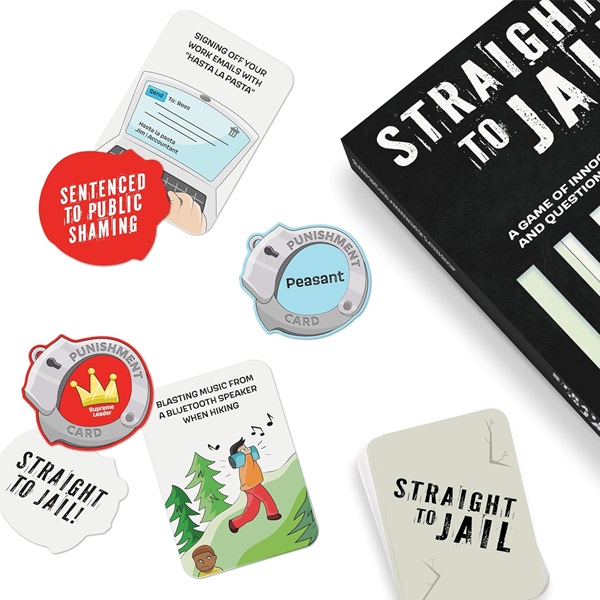Straight to Jail: What's the Verdict?

How would you judge someone who pressed the close door button on an elevator as someone ran for it? And what’s more: how would the other players at the table judge them?
Straight to Jail is a 4-12 player party game, published by Vango, all about how players judge very specific scenarios.
Gameplay
Players divide into two teams. On a team’s turn, a player is selected to be the supreme leader. He takes one set of six punishment cards. These range from ‘not only is this good, you go straight to jail if you don’t do it’ to ‘straight to jail’. Next, he draws six crime cards and places them face-up on the table. Crime cards are a range of different scenarios. Examples include ‘having a mullet’ and ‘constantly checking your phone during a conversation’.
The leader then places one punishment card face-down on each crime, assigning a punishment to each one. After he’s done, the rest of his team takes the second set of punishment cards and uses them to try to guess which punishments the supreme leader assigned to each crime. They have 30 seconds to discuss how they believe the crimes were ranked, before they must make their guess.
Answers are then revealed, and the team gets one point for each correct guess. It’s now the next team’s turn. The first team to ten points wins the game.

Review
Straight to Jail is a simple concept, making it a party game that’s easy to teach. There’s a wide range of prompts on the card, ranging from actually positive or neutral things, to annoying things, and even a few ambiguous ones that stirred up conversation at the table.
It has a 14+ age rating, but we didn’t encounter any inappropriate cards. It felt more like the humor and ideas of the game are just something that older groups are more likely to understand and enjoy.
The component quality is fair. We didn’t love the card stock, and while we appreciated that all the cards had unique artwork, the style wasn’t our favorite.
There are, unfortunately, a few design flaws. The rules specifically say the team only has thirty seconds to discuss, which can lead to some fun, frenzied debates. However, this is the kind of game where the discussion is half the fun, and putting a timer on those discussions cuts off a lot of the enjoyment. Also, the scoring system of reaching 10 points makes it possible for one team to only have one chance to play, with the team that starts first having a significant advantage. Playing a certain number of rounds would have been fairer.
Because of these drawbacks, we actually preferred playing this as a fully cooperative experience with all the players trying to work together towards a high score. The team mode definitely opens the game up for a higher player count, but for a smaller group, it was fun to have everyone at the table, discussing the cards together at the same time. It doesn’t feel as fun to have one team sitting around waiting to take their turn.
There is a fun idea at the heart of Straight to Jail. The execution is a little mixed, but it’s very easy to house rule some of the flaws to create a simple but engaging party game.
Pros: Cards are appropriate for all ages, lots of crime cards, fun discussions
Cons: Significant advantage in going first, team mode causes one group to sit out doing nothing each turn
Disclosure: we received a complimentary review copy of this game.







